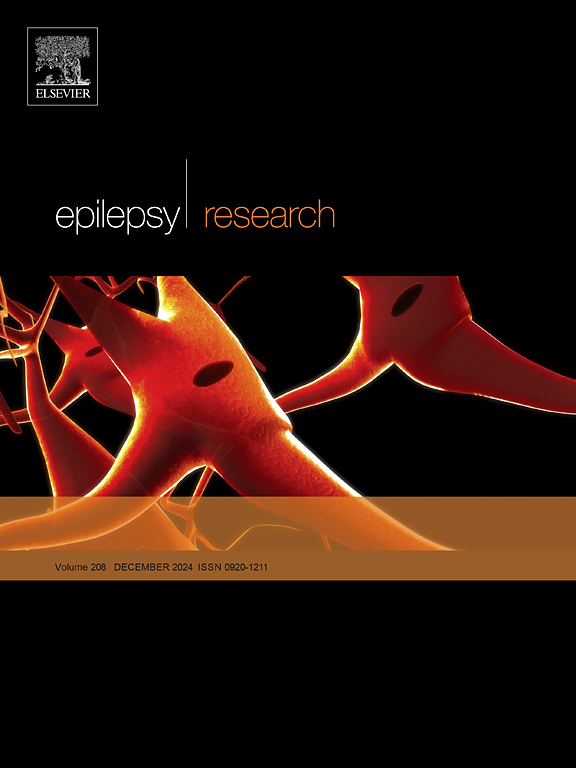Childhood-onset epilepsy: Longitudinal seizure outcomes in a large single-center cohort
IF 2
4区 医学
Q3 CLINICAL NEUROLOGY
引用次数: 0
Abstract
Objectives
Epilepsy is the most common serious neurological disorder in children; however, previous long-term studies are often limited by small sample sizes or methodological variability. This study aimed to assess the epidemiology, seizure outcomes, and prognostic factors of childhood-onset epilepsy over > 10 years of follow-up at a single tertiary center.
Methods
We retrospectively analyzed the medical records of 4248 patients diagnosed with epilepsy before age 19 between 1995 and 2017 at Asan Medical Center Children’s Hospital. All patients underwent at least one electroencephalogram (EEG) and received anti-seizure medications (ASMs) for > 2 years.
Results
During a mean follow-up of 11.0 years, 43 patients (1.0 %) died. The median age at seizure onset was 7.2 years. Etiologies included unknown (52.5 %), structural (29.3 %), genetic/metabolic (23.4 %), and infectious/autoimmune (4.5 %). Focal epilepsy was the most common (63.4 %). Neurocognitive and psychological comorbidities were observed in 32.7 % and 20.6 % of patients, respectively. Seizure freedom for ≥ 2 years was achieved in 81.2 %, and terminal remission in 63.1 %. However, relapse occurred in 38.0 %, and 28.6 % developed intractable epilepsy. Prognostic factors included status epilepticus, intellectual disability, pretreatment seizure frequency, etiology, epilepsy syndromes, and EEG abnormalities.
Conclusions
This study reaffirms known risk factors while providing comprehensive insights into seizure trajectories, relapse patterns, and treatment responses in a large cohort. It highlights the clinical relevance of the 2-year seizure-free definition and underscores the need for early interventions in high-risk subgroups. Despite diagnostic advances, several cases remain etiologically unresolved, reinforcing the importance of expanding access to molecular and imaging tools in pediatric epilepsy care.
儿童期癫痫:大型单中心队列的纵向癫痫发作结果
目的:癫痫是儿童最常见的严重神经系统疾病;然而,以往的长期研究往往受到样本量小或方法可变性的限制。本研究旨在评估儿童癫痫的流行病学、癫痫发作结局和预后因素,随访时间为 10年。方法回顾性分析1995 ~ 2017年在峨山医疗中心儿童医院诊断为19岁以下癫痫的4248例患者的病历。所有患者至少接受一次脑电图(EEG)检查,并接受抗癫痫药物治疗 2年。结果平均随访11.0年,死亡43例(1.0 %)。癫痫发作的中位年龄为7.2岁。病因包括未知(52.5 %)、结构(29.3 %)、遗传/代谢(23.4 %)和感染/自身免疫(4.5 %)。局灶性癫痫最常见(63.4 %)。神经认知和心理合并症分别为32.7% %和20.6% %。≥ 2年癫痫发作自由率为81.2 %,最终缓解率为63.1 %。然而,复发发生率为38.0% %,并发难治性癫痫28.6% %。预后因素包括癫痫持续状态、智力残疾、癫痫发作前频率、病因、癫痫综合征和脑电图异常。结论:本研究重申了已知的危险因素,同时在一个大队列中对癫痫发作轨迹、复发模式和治疗反应提供了全面的见解。它强调了2年无癫痫发作定义的临床相关性,并强调了对高危亚组进行早期干预的必要性。尽管在诊断方面取得了进展,但仍有一些病例病因不明,这加强了在儿童癫痫护理中扩大分子和成像工具可及性的重要性。
本文章由计算机程序翻译,如有差异,请以英文原文为准。
求助全文
约1分钟内获得全文
求助全文
来源期刊

Epilepsy Research
医学-临床神经学
CiteScore
0.10
自引率
4.50%
发文量
143
审稿时长
62 days
期刊介绍:
Epilepsy Research provides for publication of high quality articles in both basic and clinical epilepsy research, with a special emphasis on translational research that ultimately relates to epilepsy as a human condition. The journal is intended to provide a forum for reporting the best and most rigorous epilepsy research from all disciplines ranging from biophysics and molecular biology to epidemiological and psychosocial research. As such the journal will publish original papers relevant to epilepsy from any scientific discipline and also studies of a multidisciplinary nature. Clinical and experimental research papers adopting fresh conceptual approaches to the study of epilepsy and its treatment are encouraged. The overriding criteria for publication are novelty, significant clinical or experimental relevance, and interest to a multidisciplinary audience in the broad arena of epilepsy. Review articles focused on any topic of epilepsy research will also be considered, but only if they present an exceptionally clear synthesis of current knowledge and future directions of a research area, based on a critical assessment of the available data or on hypotheses that are likely to stimulate more critical thinking and further advances in an area of epilepsy research.
 求助内容:
求助内容: 应助结果提醒方式:
应助结果提醒方式:


